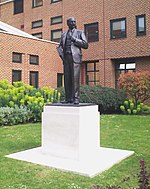Half Moon Theatre
1972 establishments in England1990 disestablishments in EnglandFormer buildings and structures in the London Borough of Tower HamletsFormer theatres in LondonPolitical theatre companies ... and 1 more
Use British English from May 2015

The Half Moon Theatre Company was formed in 1972 in a rented synagogue in Alie Street, Whitechapel, in the London Borough of Tower Hamlets. Half Moon Passage was the name of a nearby alley. The founders, Michael Irving and Maurice Colbourne, and the Artistic Director, Guy Sprung, wanted to create a cheap rehearsal space with living accommodation, inspired by the sixties alternative society. The Half Moon Young People's Theatre and Half Moon Photography Workshop were also founded at the theatre.
Excerpt from the Wikipedia article Half Moon Theatre (License: CC BY-SA 3.0, Authors, Images).Half Moon Theatre
Mile End Road, London Stepney
Geographical coordinates (GPS) Address Nearby Places Show on map
Geographical coordinates (GPS)
| Latitude | Longitude |
|---|---|
| N 51.5222 ° | E -0.0454 ° |
Address
The Half Moon
Mile End Road 213-223
E1 4AA London, Stepney
England, United Kingdom
Open on Google Maps










